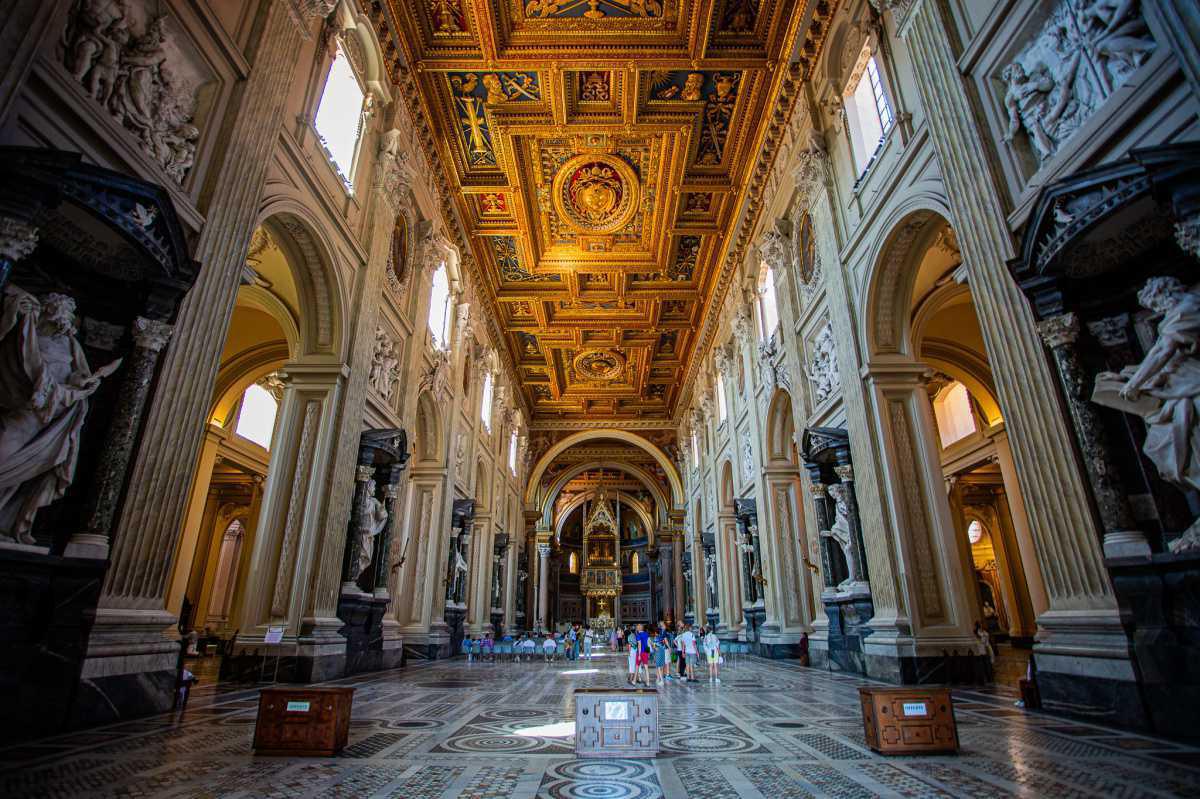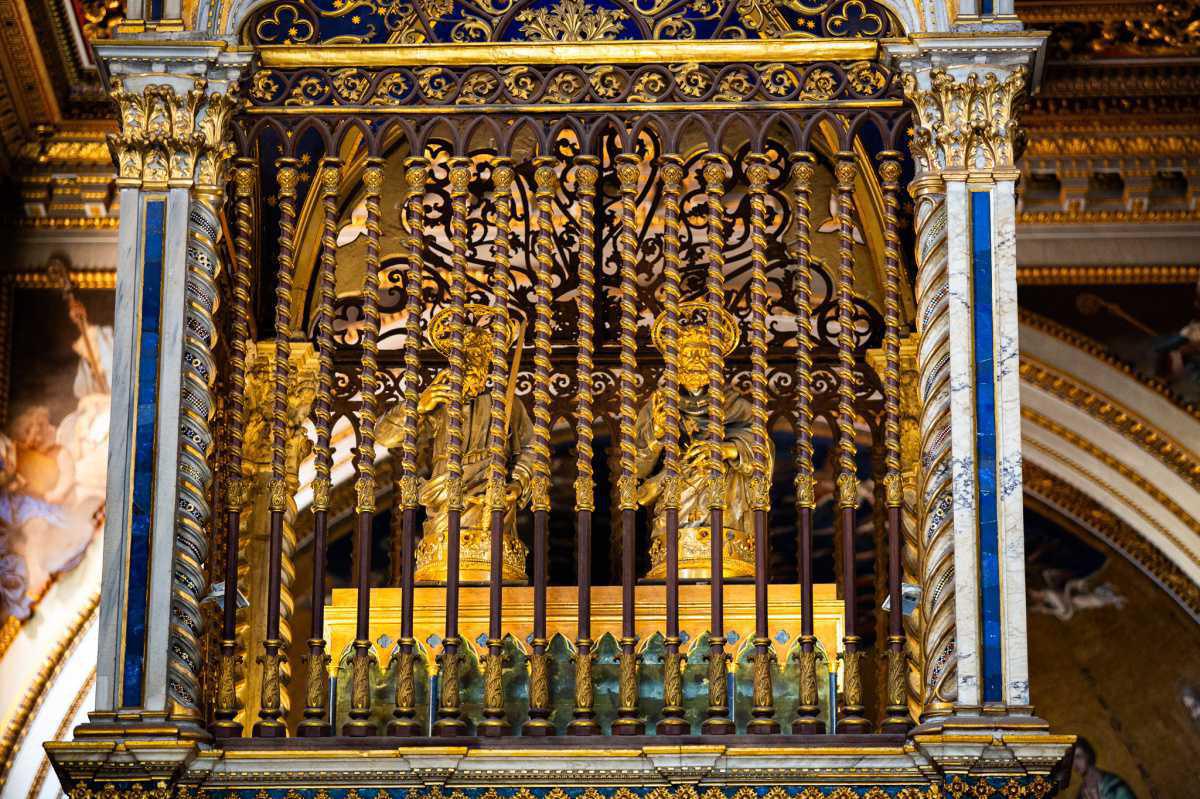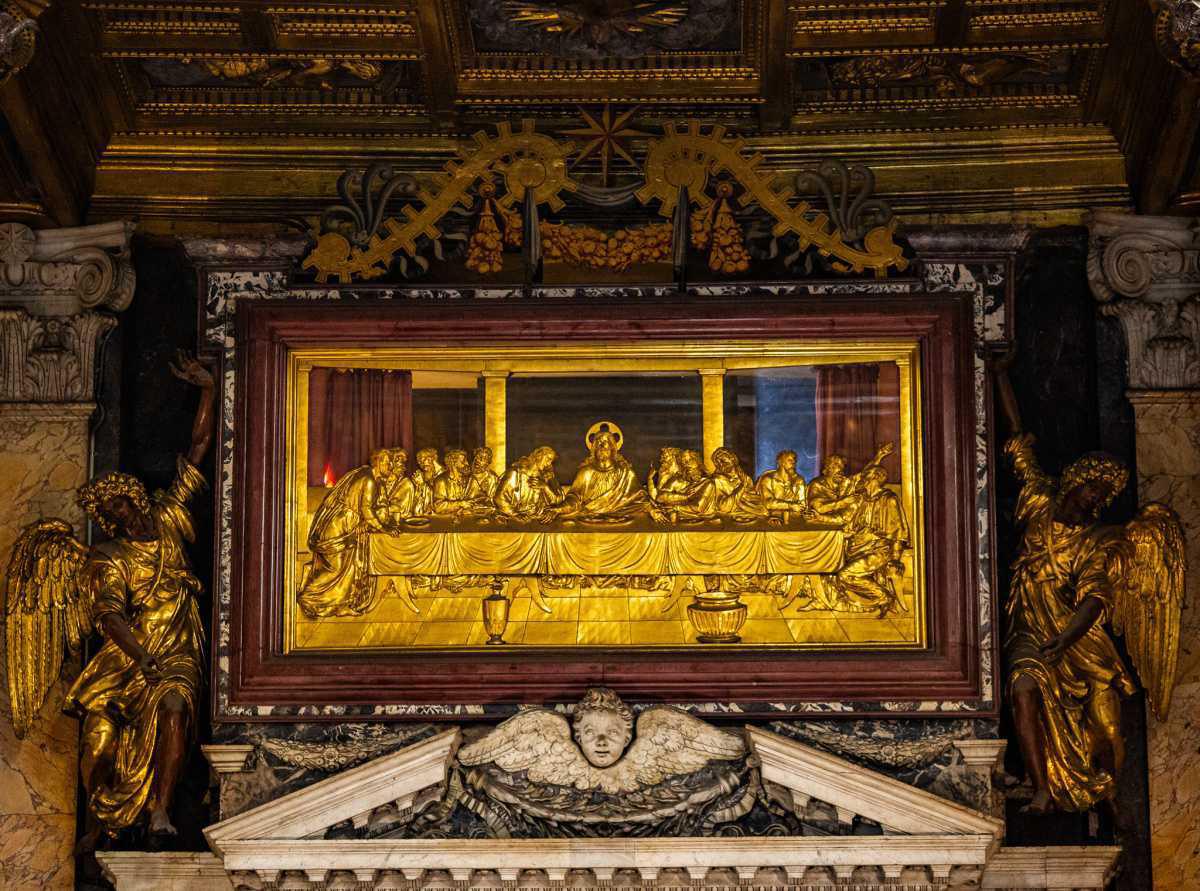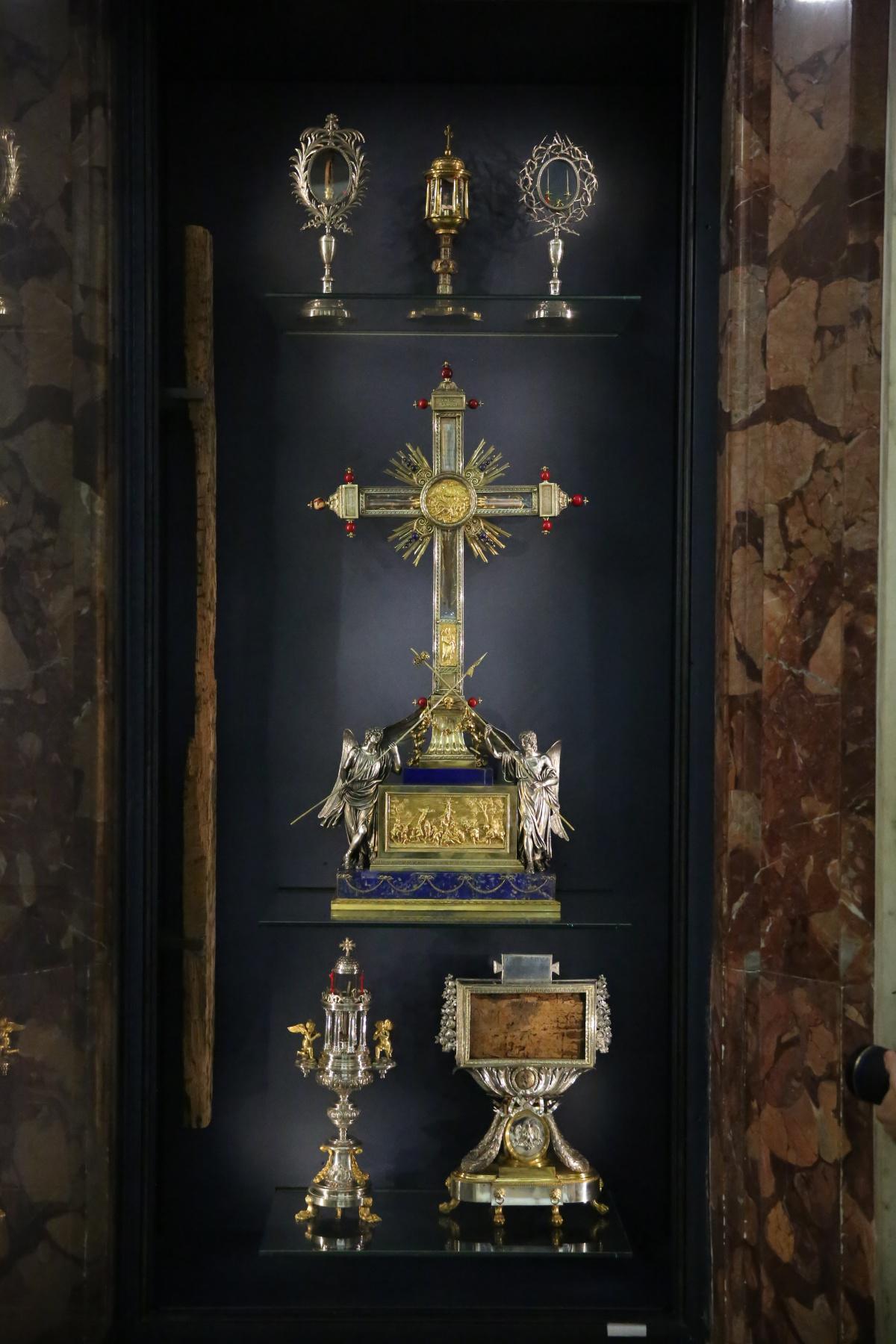
Papal Basilica of St. John Lateran
4 P.za di S. Giovanni in Laterano Roma
The Papal Basilica of St. John Lateran, known in Italian as San Giovanni in Laterano, is the oldest of the four major basilicas of Rome and the first church built after the legalization of Christianity. Established by Emperor Constantine around 311 AD, the land originally belonged to the Lateran family before being inherited by Fausta, Constantine’s wife. In an act that forever shaped Christian history, Constantine donated the site to Pope Miltiades, making it the first official church of the Bishop of Rome.
To this day, St. John Lateran serves as the cathedral of Rome and the ecclesiastical seat of the Pope, who, as Bishop of Rome, holds supreme authority over the Church. It was the official papal residence until the Avignon Papacy in the 14th century. Before the main altar rests the tomb of Pope Martin V, the pontiff who restored the papacy to Rome.
Above the ciborium, the relics of the heads of St. Peter and St. Paul are enshrined, a powerful testimony to the Church’s apostolic foundation. On the left side of the church, tradition holds that a large relic of a table displayed there is from the very table of the Last Supper, where Christ and His apostles shared the Eucharist.
As the Mother and Head of All Churches, St. John Lateran remains a place of profound significance, where the legacy of the papacy, the apostles, and the early Christian Church continues to live in sacred tradition.
Architecture and Interior
The current structure dates primarily to the 17th century, when it was renovated under Pope Innocent X by the architect Francesco Borromini in Baroque style. However, the basilica retains elements from earlier periods, including its stunning cosmatesque floor and medieval mosaics.
Key features include:
- The Central Nave – Lined with massive statues of the 12 Apostles, commissioned by Pope Clement XI in the 18th century.
- The High Altar – Houses a reliquary containing what is believed to be the heads of St. Peter and St. Paul.
- The Apse Mosaic – A stunning 13th-century mosaic depicting Christ, the Virgin Mary, and various saints.
- The Cloister – A peaceful, beautifully decorated courtyard with twisted marble columns.
- The Baptistery – One of the oldest in Christianity, built by Constantine.
Relics of Sts. Peter and Paul
Enshrined within the baldachin (a ceremonial canopy) are the skulls of Saints Peter and Paul, esteemed apostles of Christianity. These relics have been venerated at the basilica since at least the ninth century.
The presence of these relics underscores the basilica's prominence in Christian tradition, symbolizing a direct connection to the foundational figures of the Church. This practice of placing relics beneath or near the altar aligns with ancient customs, reflecting the early Christian tradition of celebrating the Eucharist over the graves of martyrs.
Relic of the Last Supper
Altar of the Holy Sacrament, a significant site for pilgrims and visitors. This altar enshrines a revered relic: a wooden table traditionally believed to have been used by Jesus during the Last Supper. The relic is housed within a 14th-century wooden ciborium, adding to its historical and spiritual significance.
The exact origin of this table is a subject of historical discussion. Some traditions assert that it was transported from Jerusalem to Rome, while others suggest it may have been adapted from an ancient Roman artifact.
The altar itself is a masterpiece of late Renaissance art, featuring a design by Pietro Paolo Olivieri around 1600. It is adorned with intricate sculptures and decorations that reflect the rich artistic heritage of the period.
This sacred relic and its ornate setting underscore the basilica's profound connection to early Christian traditions and its enduring role as a center of worship and pilgrimage.
Lateran Palace
The Lateran Palace (Palatium Lateranense), located next to the Archbasilica of Saint John Lateran in Rome, is one of the most historically significant papal residences. It served as the official residence of the Popes for nearly 1,000 years, from the 4th century until the papacy moved to the Vatican in the 14th century.
The palace was originally an imperial Roman residence belonging to the wealthy Laterani family during the early Roman Empire. However, after their downfall, Emperor Constantine the Great donated the property to the Bishop of Rome in the early 4th century, making it the first official papal residence. Excavations of this residence can be viewed with a special ticket.
From the time of Pope Sylvester I (r. 314–335) onward, the Lateran Palace became the center of papal administration and the seat of the Popes, preceding the Vatican. It was the site of many significant church councils, including five Lateran Councils between the 12th and 16th centuries.
The palace suffered extensive damage over the centuries due to fires, earthquakes, and invasions. In 1309, during the Avignon Papacy, the Popes moved to France, and by the time they returned in 1377, the Lateran Palace was in ruins. Instead of rebuilding it as their primary residence, the Popes settled in the Apostolic Palace in the Vatican, and the Lateran Palace lost its status as the papal home.
The current Lateran Palace dates to the 16th century, rebuilt under Pope Sixtus V (r. 1585–1590). The renowned architect Domenico Fontana designed the new building, which is connected to the Lateran Basilica.
Today, the Lateran Palace houses:
- The Pontifical Lateran University, a major institution for theological studies.
- The Historical Museum of the Vatican, displaying artifacts related to papal history.
- Reception halls used for official Vatican events and diplomatic meetings.
After visiting both the papal basilica, cloister, and palace, walk across the street to the building conaining the Holy Stairs.
Holy Stairs (Scala Sancta)
One of the most famous features near the Lateran Palace is the Scala Sancta, a set of 28 marble steps believed to have been brought from Pontius Pilate’s palace in Jerusalem by St. Helena, the mother of Constantine. Tradition holds that Jesus walked these steps during his trial before Pilate. For centuries, pilgrims have ascended the stairs on their knees, in an act of penance and devotion, while meditating on Christ’s suffering. This practice remains popular, especially during Holy Week.
According to tradition, the Scala Sancta was brought to Rome in the 4th century by St. Helena, the mother of Emperor Constantine the Great. St. Helena was a devout Christian and is credited with discovering several key relics of Christ’s Passion, including the True Cross. The stairs were originally placed in the Lateran Palace, which served as the papal residence for nearly 1,000 years. Visitors can see them today just a block away at the Basilica of Santa Croce in Gerusalemme (Holy Cross in Jeruselem).
In 1589, under Pope Sixtus V, the stairs were moved to their current location in a special building designed by Domenico Fontana, right next to the Lateran Basilica.
The Sancta Sanctorum (Holy of Holies) at the top, which was once the private chapel of the Popes when they lived in the Lateran Palace.
Prayer
Heavenly Father,
as I stand in awe within the ancient walls of St. John Lateran,
the Mother and Head of All Churches,
I bring my heart before You in faith and reverence.
Through the legacy of Emperor Constantine,
who gifted this sacred site to Your Church,
may I be drawn closer to Your eternal love.
Guide me through the history that enshrines the apostles,
and let this holy place be a testament of my faith in You.
May the relics of Saints Peter and Paul
remind me of the apostolic foundation of the Church,
and may the table of the Last Supper inspire me to live
in communion with Christ and my brothers and sisters.
Bless my journey, Lord, and grant me the grace
to embrace the sacred traditions that connect me
to the early Christian Church and its enduring legacy.
Amen.
Recommended Nearby:
Basilica of the Holy Cross in Jeruselem (Santa Croce in Gerusalemme)
This church is reknown for essential relics that bear witness to the life, death, and resurrection of Jesus Christ. According to tradition, in 326 AD, Empress St. Helena, mother of Emperor Constantine, embarked on a pilgrimage to Jerusalem, where she recovered sacred relics linked to the suffering and death of Christ. Among these was a fragment of the True Cross, which she carried back to Rome.
How to Locate the Restrooms
At Saint John Lateran, the restrooms are located on the left side of the basilica. Look for the sign.
See Also:
Papal Basilicas - Self Guided Tour
Located throughout Rome, each papal basilica carries a rich story with many pilgrims to Rome making the journey to each one before choosing a favorite. By passing through the Holy Door of any of these basilicas, it is possibe to receive a plenary indulgence during the 2025 Jubilee Year.
Holy Week - Relics in Rome Walking Tour
Dive into Lenten and/or Holy Week spirituality by learning about relics of passion of Jesus in Rome.
Stay Connected:
Sign up and get weekly updates with new locations, intenaries and videos.



